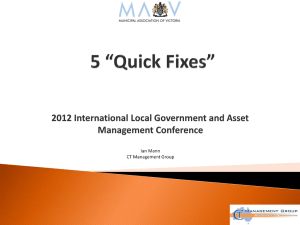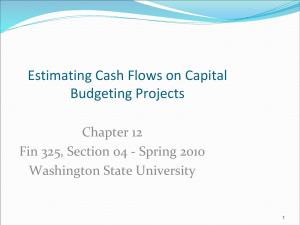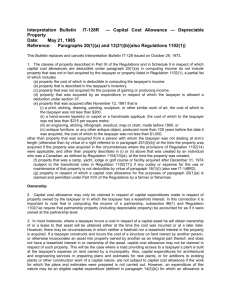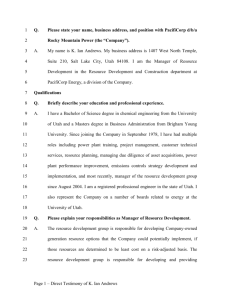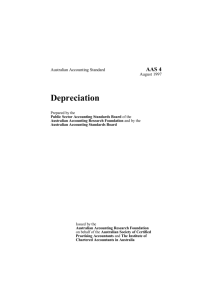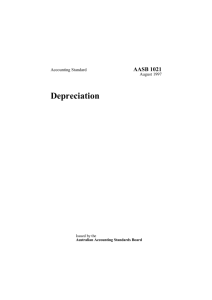Attachment L - A Comprehensive Capital Allowance System
advertisement
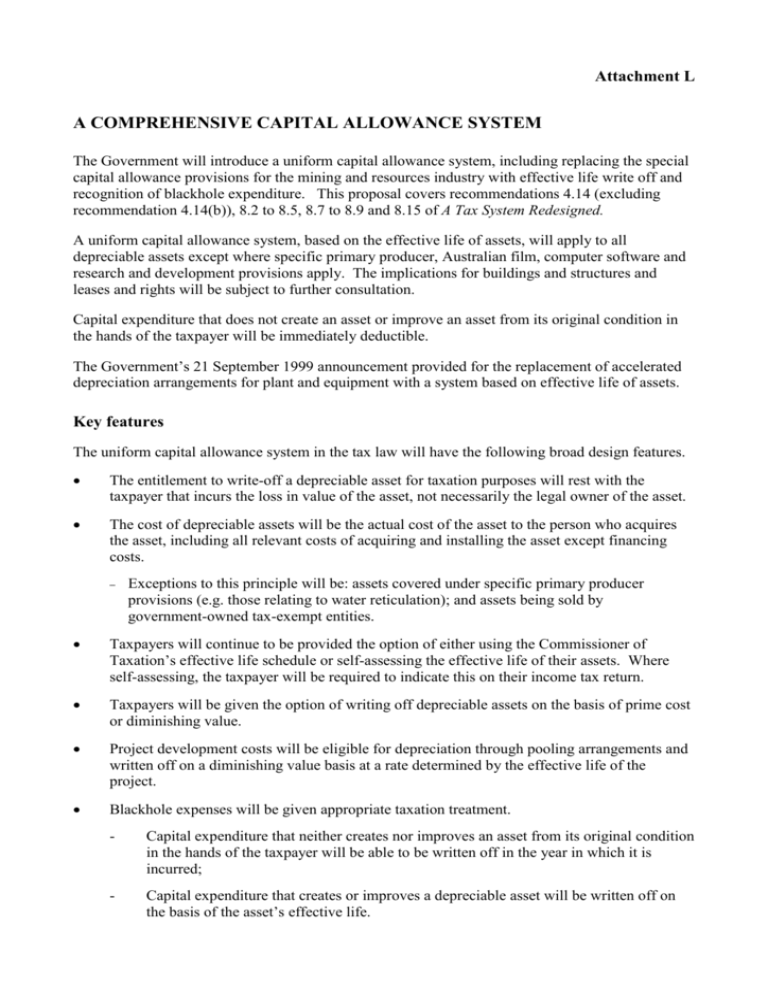
Attachment L A COMPREHENSIVE CAPITAL ALLOWANCE SYSTEM The Government will introduce a uniform capital allowance system, including replacing the special capital allowance provisions for the mining and resources industry with effective life write off and recognition of blackhole expenditure. This proposal covers recommendations 4.14 (excluding recommendation 4.14(b)), 8.2 to 8.5, 8.7 to 8.9 and 8.15 of A Tax System Redesigned. A uniform capital allowance system, based on the effective life of assets, will apply to all depreciable assets except where specific primary producer, Australian film, computer software and research and development provisions apply. The implications for buildings and structures and leases and rights will be subject to further consultation. Capital expenditure that does not create an asset or improve an asset from its original condition in the hands of the taxpayer will be immediately deductible. The Government’s 21 September 1999 announcement provided for the replacement of accelerated depreciation arrangements for plant and equipment with a system based on effective life of assets. Key features The uniform capital allowance system in the tax law will have the following broad design features. x The entitlement to write-off a depreciable asset for taxation purposes will rest with the taxpayer that incurs the loss in value of the asset, not necessarily the legal owner of the asset. x The cost of depreciable assets will be the actual cost of the asset to the person who acquires the asset, including all relevant costs of acquiring and installing the asset except financing costs. Exceptions to this principle will be: assets covered under specific primary producer provisions (e.g. those relating to water reticulation); and assets being sold by government-owned tax-exempt entities. x Taxpayers will continue to be provided the option of either using the Commissioner of Taxation’s effective life schedule or self-assessing the effective life of their assets. Where self-assessing, the taxpayer will be required to indicate this on their income tax return. x Taxpayers will be given the option of writing off depreciable assets on the basis of prime cost or diminishing value. x Project development costs will be eligible for depreciation through pooling arrangements and written off on a diminishing value basis at a rate determined by the effective life of the project. x Blackhole expenses will be given appropriate taxation treatment. - Capital expenditure that neither creates nor improves an asset from its original condition in the hands of the taxpayer will be able to be written off in the year in which it is incurred; - Capital expenditure that creates or improves a depreciable asset will be written off on the basis of the asset’s effective life. 2 - Capital expenditure that creates or improves a non-depreciable asset will be incorporated into the asset’s cost base which would reduce the taxable gain (or increase the allowable loss) when the asset is disposed of. - Where it is not practical to ascribe an effective life to a particular class of capital expenditure, special write-offs will apply, for example, to the costs of establishing an entity and the costs of raising equity and borrowings for an indefinite period. Under this measure, business establishment costs and equity raisings will be eligible for write-off over five years and loan raisings will be able to be written off over the lesser of the life of the loan or five years. x Blackhole expenses relating to leases and rights, other than mining or prospecting rights, will be subject to further consultation as part of the consideration of the leases and rights regime (Recommendation 4.14(b)). x As already announced on 21 September 1999, in relation to depreciable assets held for business purposes taxpayers will be permitted to vary depreciation rates, either up or down to reflect market or technological developments or other factors connected with usage. The Commissioner of Taxation will publish separate guidelines to assist taxpayers to determine the conditions under which depreciation rates can be varied. Taxpayers will be required to indicate in their income tax returns whether there has been any variation to the depreciation rates of their assets since their previous return. x Also announced on 21 September 1999, from 1 July 2000 taxpayers will be able to write off all depreciable assets costing, or with an opening written down value, less than $1000 through a low-value pool. Commencement date The uniform capital allowance system will apply to assets commenced to be constructed or acquired under contracts on or after 1 July 2001 and to blackhole expenses incurred on or after 1 July 2001. As announced on 21 September 1999, the effective life regime already applies to plant and equipment. Current arrangements There are over 37 separate capital allowances regimes that are not consistent. Why the change is needed A uniform system of capital allowances based on a common set of principles will offer significant simplification benefits. The existing separate regimes are complex, inconsistent and involve significant replication in the tax law. The collapse of the separate regimes into a single comprehensive regime provides a framework under which blackhole expenses can be recognised. A uniform system of capital allowances would provide a more neutral tax treatment for capital expenditures and hence should improve the quality of investment and economic efficiency. Consultation proceeding Exposure draft legislation covering many of the features of the uniform system of capital allowances (Division 40 of the new law) was released along with the Ralph Report A Tax System Redesigned. Views and comments from consultations will be considered for the finalisation of legislation to be presented to the Parliament.





